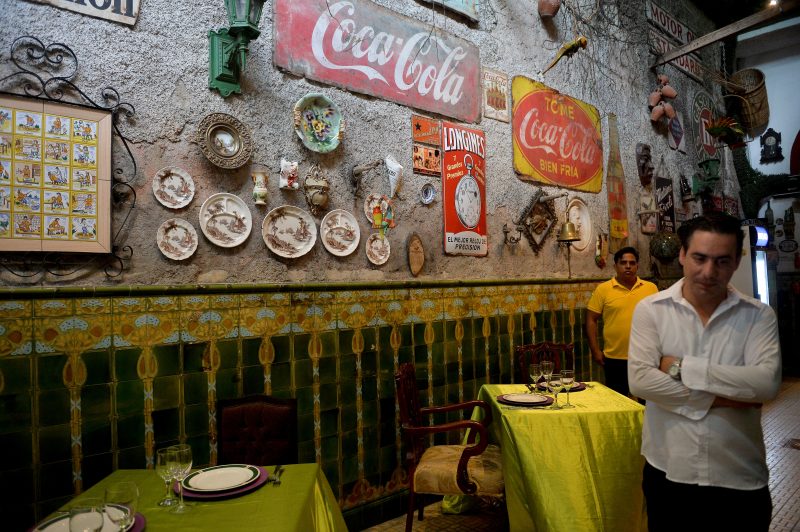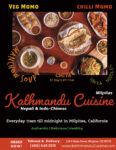Cubans feeling the pinch as Trump cruise ban bites
A waiter waits for clients at San Cristobal restaurant in Havana, enduring a slowdown blamed on new US sanctions (YAMIL LAGE)
Havana (AFP) – The waxy sheen on his splendid 1934 Ford glimmers in the Caribbean sun, but nobody is hiring Estaban Estrada’s red and white convertible these days — the dollars have dried up now that US cruise liners are no longer calling at Havana.
Estrada’s pride and joy is one of a line of classic American automobiles lined up outide Havana’s baroque-style Cathedral, mostly idle since the Trump administration re-imposed travel restrictions this month.
“We are all stopped when normally we would all be working,” says Estrada, as dozens of his colleagues shoot the breeze on nearby benches. “And this has been going on now for several days.”
He calls out to two passing women: “Taxi, princesses?”
Business had been good. In 2014, then-president Barack Obama broke new diplomatic ground with the communist-run island and its leader Raul Castro.
US cruise liners began calling at Havana as decades of Cold War chill thawed. Estrada began taking American tourists around Havana’s must-sees: the Malecon, Revolution Square and the Capitol.
The San Cristobal restaurant on San Rafael street became a landmark on the tourist trail after Obama dined there during his breakthrough trip in 2016.
Owner Carlos Cristobal Marques has seen a sharp downturn in business in recent weeks. “Today we are 20 percent full, yesterday we served only six tables all day.”
– ‘No plan B’ –
Nearly 900,000 tourists visited the island on cruise ships last year, according to official figures.
Almost 40 percent were American tourists bringing much-needed dollars after nearly six decades of US embargo.
Cuba seemed set to welcome record numbers of US cruise ship tourists this year, with 250,000 arriving in the first four months of 2019 alone, double the rate of the previous year.
Then, on June 4, President Donald Trump made good on his threat to tighten the economic squeeze on Cuba, angered over Havana’s support for Venezuela’s socialist regime.
On June 5, the old American cars lined up on Havana’s dockside as the last American ship sailed out, their drivers waving, bidding farewell to a regular source of dollars after Trump targeted the most common way US tourists visit the island.
“European tourists usually come in the winter, so the ones that allowed us to keep working were American tourists from the cruise ships,” Estrada says.
Their departure means the Cuban state is also denied revenue from docking fees and taxes paid by the cruise companies.
“Yesterday, I did not work for the day,” says Hector, who drives an old Chevrolet. “I’m giving myself a month, six weeks tops, and if it goes on like this, I’m turning in my licence.”
Costs must be paid regardless of business, he says — licence, parking, gas and insurance cost up to $30 a day.
Like his colleagues, he says the Cuban authorities, taken off guard by Trump’s cruise ship ban, “have no Plan B”.
– Generous Americans –
Instead, Trump’s policies have driven Cuba “backwards”.
Yoel Montano, 44, had bet heavily on the surge of American tourists. A farmer, he left his tobacco fields to ply Havana’s tourist trade with a horse and carriage. Now his mare “Mulata” stands idle in the shade of a tree in the old town.
“When the cruise ships came, the whole country was alive, there were a lot of tourists. Today, the places are empty. It’s too sad.”
Trump “wants to finish us. He’s crazy!”
The US president had deprived him of “the best tourists, Americans. They are kind.”
At the “Al Pirata” restaurant in the cobbled streets of the tourist quarter, proprietor Eddy Basulto bemoans the departure of the Americans, who he says were “big tippers.”
“Our business is down 60 percent,” says Basulto.
“This morning, I only sold two breakfasts. But whenever the cruise ship arrived, I had three sittings in a row.”
Disclaimer: Validity of the above story is for 7 Days from original date of publishing. Source: AFP.


